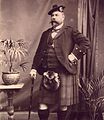
A kilt is a type of knee-length non-bifurcated skirt with pleats at the back, originating in the traditional dress of Gaelic men and boys in the Scottish Highlands. It is first recorded in the 16th century as the great kilt, a full-length garment whose upper half could be worn as a cloak. The small kilt or modern kilt emerged in the 18th century, and is essentially the bottom half of the great kilt. Since the 19th century, it has become associated with the wider culture of Scotland, and more broadly with Gaelic or Celtic heritage. It is most often made of woollen cloth in a tartan pattern.

A waistcoat in BrE, or vest in AmE, is a sleeveless upper-body garment. It is usually worn over a dress shirt and necktie and below a coat as a part of most men's formal wear. It is also sported as the third piece in the traditional three-piece male lounge suit. Any given vest can be simple or ornate, or for leisure or luxury. Historically, the vest can be worn either in the place of or underneath a larger coat dependent upon the weather, wearer, and setting.
Formal wear, formal attire or full dress is the traditional Western dress code category applicable for the most formal occasions, such as weddings, christenings, confirmations, funerals, Easter and Christmas traditions, in addition to certain state dinners, audiences, balls, and horse racing events. Formal wear is traditionally divided into formal day and evening wear; implying morning dress before 6 p.m., and white tie after 6 p.m. Generally permitted other alternatives, though, are the most formal versions of ceremonial dresses, full dress uniforms, religious clothing, national costumes, and most rarely frock coats. In addition, formal wear is often instructed to be worn with official full size orders and medals.

The Calgary Highlanders is a Canadian Army Primary Reserve infantry regiment, headquartered at Mewata Armouries in Calgary, Alberta, Canada. The regiment is a part-time reserve unit, under the command of 41 Canadian Brigade Group, itself part of 3rd Canadian Division, one of four region-based Canadian Army divisions. The regiment is one of only two regiments in the Canadian Forces to wear an honorary distinction on their uniform, commemorating the counterattack at Kitcheners' Wood. On 9 January 2015, the regiment was recognized with the Canadian Forces' Unit Commendation for outstanding contributions to the war in Afghanistan.
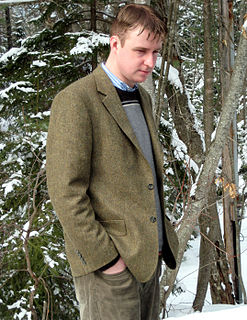
A jacket is a garment for the upper body, usually extending below the hips. A jacket typically has sleeves, and fastens in the front or slightly on the side. A jacket is generally lighter, tighter-fitting, and less insulating than a coat, which is outerwear. Some jackets are fashionable, while others serve as protective clothing. Jackets without sleeves are vests.

The sporran, a traditional part of male Scottish Highland dress, is a pouch that performs the same function as pockets on the pocketless kilt. Made of leather or fur, the ornamentation of the sporran is chosen to complement the formality of dress worn with it. The sporran is worn on a leather strap or chain, conventionally positioned in front of the groin of the wearer.

Mess dress uniform is the most-formal or semi-formal type of uniforms used by military personnel, police personnel, firefighters and other public uniformed services members for certain ceremonies, receptions, and celebrations, in messes or on private occasions. It frequently consists of a mess jacket, trousers, white dress shirt, often with standing collar and bow tie, along with orders and medals insignia. Design may depend on regiment or service branch, e.g. army, navy, air force, marines, etc. In Western dress codes, mess dress uniform is a permitted supplementary alternative equivalent to the civilian black tie for evening wear or black lounge suit for day wear - sometimes collectively called half dress - although military uniforms are the same for day and evening wear. As such, mess dress uniform is considered less formal than full dress uniform, but more formal than service dress uniform.
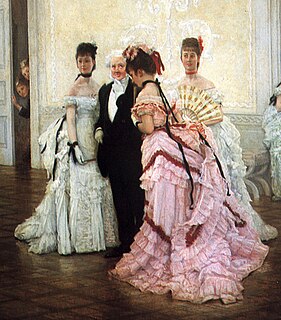
1870s fashion in European and European-influenced clothing is characterized by a gradual return to a narrow silhouette after the full-skirted fashions of the 1850s and 1860s.
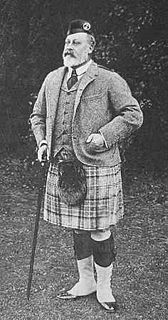
Highland dress is the traditional, regional dress of the Highlands and Isles of Scotland. It is often characterised by tartan. Specific designs of shirt, jacket, bodice and headwear may also be worn along with clan badges and other devices indicating family and heritage.

Highland dance or Highland dancing is a style of competitive dancing developed in the Scottish Highlands in the 19th and 20th centuries, in the context of competitions at public events such as the Highland games. It was created from the Gaelic folk dance repertoire, but formalised with the conventions of ballet', and has been subject to influences from outside the Highlands. Highland dancing is often performed with the accompaniment of Highland bagpipe music, and dancers wear specialised shoes called ghillies. It is now seen at nearly every modern-day Highland games event.
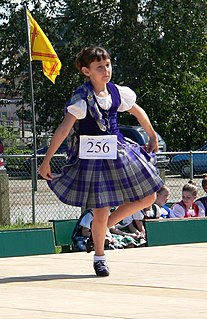
The aboyne dress is the name given to the prescribed attire for female dancers in the Scottish national dances, such as the Flora MacDonald's fancy, the Scottish lilt, and others. Male dancers wear the kilt for these dances, the kilt being a male garment. There are two versions of the aboyne dress in use. Some consider the aboyne as quite suited to the graceful movements of the National dances.
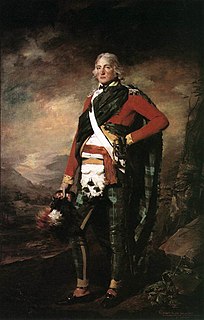
Trews are men's clothing for the legs and lower abdomen, a traditional form of tartan trousers from Scottish Highland dress. Trews could be trimmed with leather, usually buckskin, especially on the inner leg to prevent wear from riding on horseback.

1850s fashion in Western and Western-influenced clothing is characterized by an increase in the width of women's skirts supported by crinolines or hoops, the mass production of sewing machines, and the beginnings of dress reform. Masculine styles began to originate more in London, while female fashions originated almost exclusively in Paris.
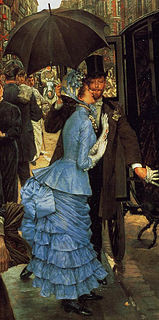
Fashion in the 1880s in Western and Western-influenced countries is characterized by the return of the bustle. The long, lean line of the late 1870s was replaced by a full, curvy silhouette with gradually widening shoulders. Fashionable waists were low and tiny below a full, low bust supported by a corset. The Rational Dress Society was founded in 1881 in reaction to the extremes of fashionable corsetry.

The modern, tailored kilt which is ubiquitous at Highland games gatherings around the world has associated with it an evolving style of wear. This style includes the accessories and other accoutrements which are typically worn with it. In this sense, it is very much like other items of the fashion world.

The history of the kilt stretches back to at least the end of the 16th century. The kilt first appeared as the belted plaid or great kilt, a full length garment whose upper half could be worn as a cloak draped over the shoulder, or brought up over the head as a hood. The small kilt or walking kilt did not develop until the late 17th or early 18th century, and is essentially the bottom half of the great kilt.

Service Dress was the new style of khaki service dress uniform introduced by the British Army for use in the field from the early 1900s, following the experiences of a number of imperial wars and conflicts, including the Second Boer War. This variant of uniform continues to be worn today, although only in a formal role, as No. 2 Pattern dress.

The uniforms of the United States Air Force are the standardized military uniforms worn by airmen of the United States Air Force to distinguish themselves from the other services.
The uniforms of the United States Army distinguish soldiers from other service members. U.S. Army uniform designs have historically been influenced by British and French military traditions, as well as contemporary U.S. civilian fashion trends. The two primary uniforms of the modern U.S. Army are the Army Combat Uniform, used in operational environments, and the Army Green Service Uniform worn during everyday professional wear and during formal and ceremonial occasions that do not warrant the wear of the more formal blue service uniform.

Doublet is the term describing any of several types of jacket worn with Scottish highland dress; referring to both uniform and evening jackets.




